One of the most common solar system sizes in Australia is 3 kilowatts (kW). 3kW solar system strike the right balance between size and affordability, costing on average about $4,700 for a system using decent quality components. But can a home go off-grid with a 3kW solar system and a battery bank? This article takes a look at some scenarios to help you decide if going off-grid is a possibility for your home. The results are based on a solar+storage system sizing tool that Solar Choice is developing in-house which we will eventually be making available to the general public.
Can you be energy self-sufficient with solar-plus-storage? It depends…
Let’s say you have a 3kW solar system on your roof with no access to a generous solar feed-in tariff incentive. There are a number of factors that influence how easily a home could go off grid with a system of this size.
These include:
- Sunny location: Some places receive more sunlight than others. A roof in Darwin receives more sunshine than one in Brisbane, while a Brisbane rooftop would see more sun than one in Melbourne.
- Optimal roof orientation and tilt: In Australia, north-facing rooftops whose tilt is roughly at the same angle as the location’s latitude produce the most power. East and west-facing arrays tend to produce a bit less. (Read more about tilt & orientation for solar panels in Australia.)
- Low energy consumption level: If your home consumes more than 15kWh per day, then a 3kW solar array will probably not meet all of your energy needs – even if you have batteries to store the sunshine for nighttime use.
- Higher energy consumption during daylight hours: If you use most of your electricity during the daylight hours, you won’t need as large a battery bank because you’ll likely consume the solar energy directly, as it is being produced. (Read more about energy consumption patterns here.)
If your home ticks all of these boxes, it could very well be possible for you to be mostly energy self-sufficient with just solar and batteries.
Compare Solar & Battery Quotes
Please note that the figures below are estimates only and should not be taken as final-word advice. Please speak with a solar/storage installer before choosing your final system size. Importantly, our model does not take into account battery or inverter power output limitations – meaning that it may not be possible for your battery system to meet sudden, large surges in demand (e.g. running a vacuum while the washing machine is on).
Some examples where going off-grid might be possible with a north-facing 3kW solar system
Sydney – 5kWh daily consumption, 8-10kWh battery storage, mostly daytime usage
This home would ordinarily have about 2 day’s worth of energy independence (‘autonomy’) following one day of sunny weather on the average day. The situation would get difficult, however, during extended rainy periods or even during periods where the home consumed more energy than usual – for example, 8kWh on a single day instead of only 5kWh. Furthermore, energy usage would need to be curtailed during the winter to ensure that the lower solar supply doesn’t mean a completely depleted battery bank. A diesel generator wouldn’t be a bad idea if the occupants want to avoid running out of electricity in the winter months.
A household using only 3kWh of electricity daily and with a 10kWh battery would stand a better chance of going off-grid without a generator; after a day of sunny weather, they’d have enough energy stored to carry them for over 3 days, even in winter. However, anyone pursuing this route should be advised that genset costs – both initial and running – can be quite high, so installing one should be considered with caution.
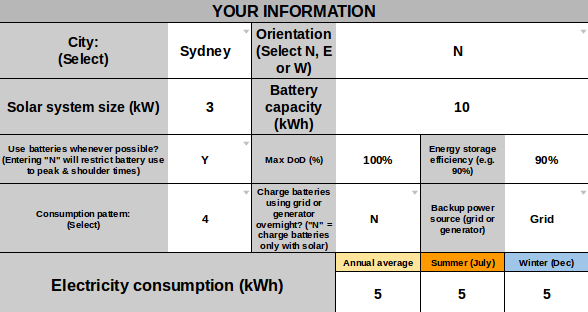 Input parameters for a home with a 3kW solar system in Sydney using Solar Choice’s battery storage sizing calculator. (Click to enlarge.)
Input parameters for a home with a 3kW solar system in Sydney using Solar Choice’s battery storage sizing calculator. (Click to enlarge.)
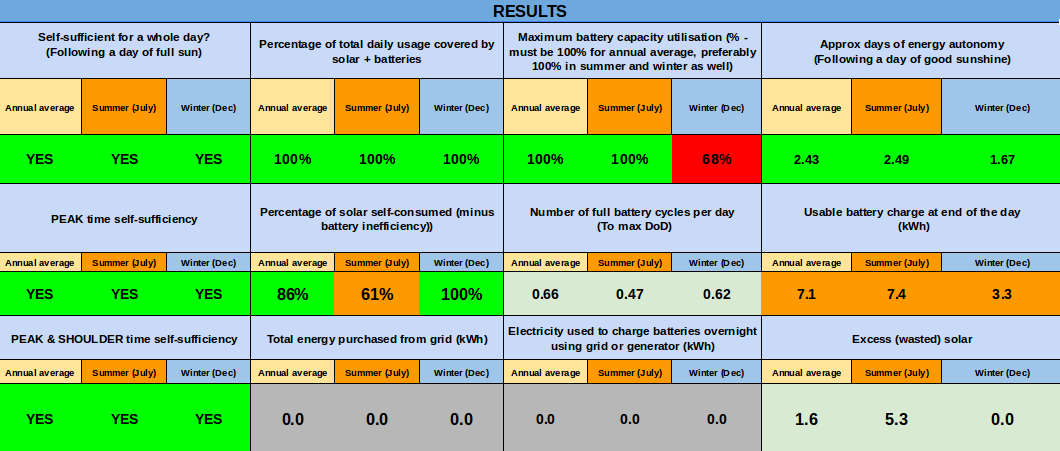 Calculator output results based on the scenario above. (Click to enlarge.)
Calculator output results based on the scenario above. (Click to enlarge.)
Brisbane – 5kWh daily consumption 11-13kWh battery storage, mostly daytime usage
The situation for a Brisbane home with 3kW of solar is not significantly different than the one for a Sydney home in terms of the possibility of being energy self-sufficient. The extra sunshine that the average Brisbane roof receives, however, means that it is possible to install a slightly larger battery bank to capture excess solar energy. The home would have about 2.5 days of energy autonomy on average, but only about 2 in the winter – which might warrant trying to reduce electricity usage down to about 4kWh per day instead.
As with Sydney, reducing consumption to about 3kWh per day would leave a lot more wiggle room with regard to energy autonomy – allowing the home to have nearly 4 days of energy autonomy on average (after a full day of sun), and about 3.5 in the winter.
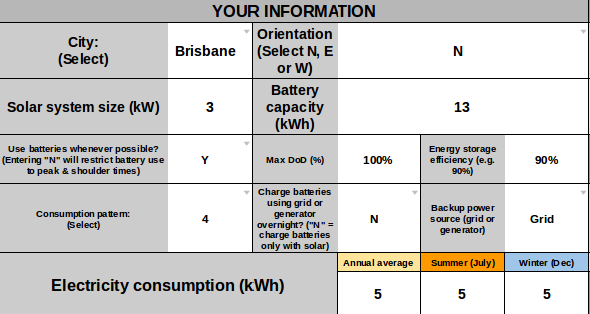 Input parameters for a home with a 3kW solar system in Brisbane using Solar Choice’s battery storage sizing calculator. (Click to enlarge.)
Input parameters for a home with a 3kW solar system in Brisbane using Solar Choice’s battery storage sizing calculator. (Click to enlarge.)
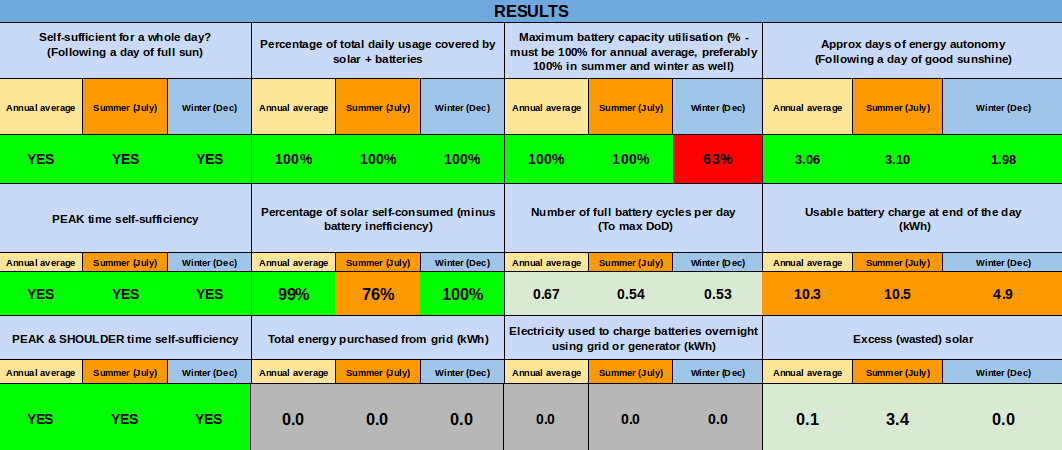 Calculator output results based on the scenario above. (Click to enlarge.)
Calculator output results based on the scenario above. (Click to enlarge.)
Melbourne – 3kWh daily consumption, 3-4kWh battery storage, mostly daytime use
Meeting household demand only with solar plus storage in Melbourne would prove to be a much more difficult endeavour than in Sydney or Brisbane due to the lower levels of sunshine. Even consuming only 3kWh per day on average throughout the year, a 3kWh battery bank would not be fully charged up in the winter. The smartest thing to do here (if space and budget allow) would be to increase the solar system size by about 2kW (to a total of 5kW) and ensure that the additional panels are north-facing and angled to take most advantage of the winter sun (tilted up higher than latitude).
But even then, the low level of solar irradiation so far south would prove to be a challenge to any Melbourne homeowner hoping to get off the grid with solar and batteries alone. Sharp reductions in electricity consumption or a diesel genset may be necessary to achieve any kind of energy autonomy throughout the year.
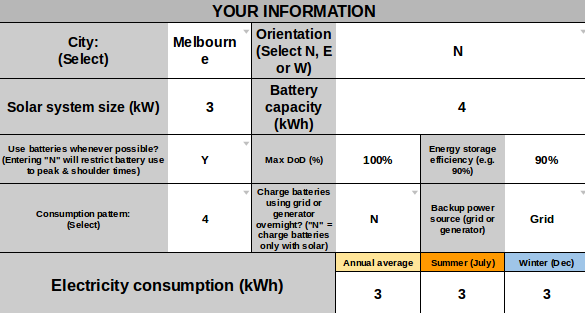 Input parameters for a home with a 3kW solar system in Melbourne using Solar Choice’s battery storage sizing calculator. (Click to enlarge.)
Input parameters for a home with a 3kW solar system in Melbourne using Solar Choice’s battery storage sizing calculator. (Click to enlarge.)
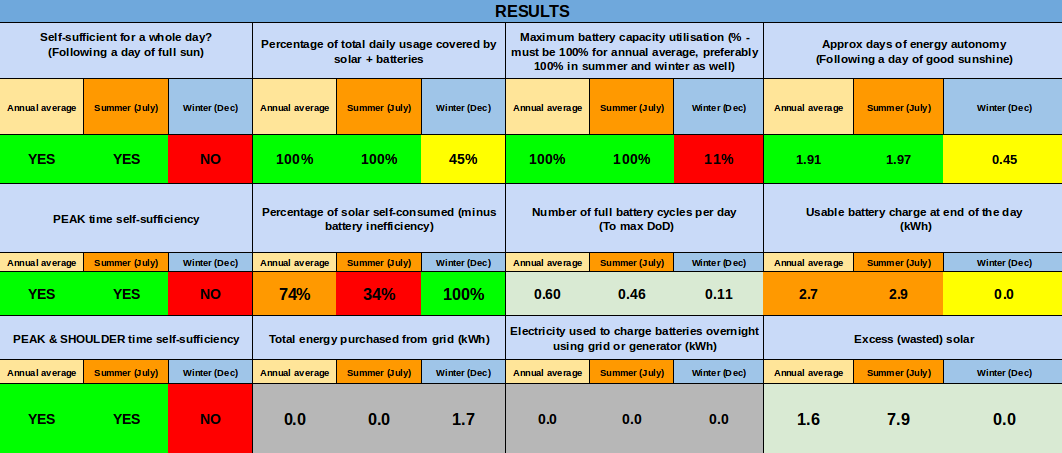 Calculator output results based on the scenario above. It’s clear that it would be quite difficult for a Melbourne home to be energy self-sufficient with a 3kW solar system, even with extremely low electricity usage – particularly in the winter. Additional solar capacity would probably be a worthwhile investment, however. (Click to enlarge.)
Calculator output results based on the scenario above. It’s clear that it would be quite difficult for a Melbourne home to be energy self-sufficient with a 3kW solar system, even with extremely low electricity usage – particularly in the winter. Additional solar capacity would probably be a worthwhile investment, however. (Click to enlarge.)
Request a free, impartial Quote Comparison
Compare Solar & Battery Quotes
© 2016 Solar Choice Pty Ltd
Consumers thinking of going completely on Solar need to realise that, solar radiation changes not only day to day, but season to season also. So the solar power pack which is generating enough power to run your home in summer, will not generate the same during winters. Thus it is advisable to use solar as a “power saver” and rely partially on the grid supply, unless ofcourse you are so remote that you dont have a choice.
I do also recommend a grid tied solar power pack vs a off grid solar power, esp if you have a net metering facility with your grid. This removes the need for expensive batteries from your solar power pack. It also reduces the cost of replacing the batteries after a couple of years. It is the battery that KILLS off grid solar.